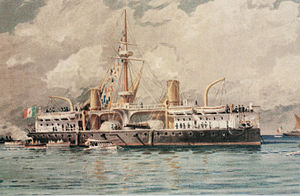Ruggiero di Lauria-class ironclad

Painting of Ruggiero di Lauria
|
|
| Class overview | |
|---|---|
| Name: | Ruggiero di Lauria class |
| Builders: | |
| Operators: |
|
| Preceded by: | Italia class |
| Succeeded by: | Re Umberto class |
| Built: | 1881–1891 |
| In commission: | 1888–1911 |
| Planned: | 3 |
| Completed: | 3 |
| Retired: | 3 |
| General characteristics | |
| Type: | ironclad battleship |
| Displacement: |
|
| Length: | 105.9 m (347.4 ft) length overall |
| Beam: | 19.84 m (65.1 ft) |
| Draft: | 8.29 to 8.37 m (27.2 to 27.5 ft) |
| Installed power: | |
| Propulsion: | 2-shafts, 2 compound steam engines |
| Speed: | 16 to 17 knots (30 to 31 km/h; 18 to 20 mph) |
| Endurance: | 2,800 nmi (5,186 km) at 10 knots (19 km/h; 12 mph) |
| Complement: | 507–509 |
| Armament: |
|
| Armor: |
|
The Ruggiero di Lauria class was a class of ironclad battleships built for the Italian Regia Marina (Royal Navy) during the late 19th century. The three ships—Ruggiero di Lauria, Francesco Morosini, and Andrea Doria—were improved versions of the earlier Caio Duilio-class battleships. The primary improvements were new breech-loading guns, better armor protection, and more powerful machinery. The ships, designed by Giuseppe Micheli, marked a temporary diversion from the ideas of Benedetto Brin, who had designed the two preceding classes along with the following class.
Construction of the ships was very lengthy, and by the time they were completed, the first pre-dreadnought battleships were being built. Rendered obsolescent by these new ships, the Ruggiero di Laurias had limited careers. The spent their time in service alternating between the Active and Reserve Squadrons, and they were primarily occupied with conducting training exercises. The ships were removed from service in 1909–11; Francesco Morosini was expended as a target ship, while Ruggiero di Lauria became a floating oil tank and Andrea Doria was converted into a depot ship. During World War I, Andrea Doria returned to service as a guard ship before being repurposed for oil storage after the war, eventually being broken up in 1929. Ruggiero di Lauria survived until 1943, when she was sunk by bombers during World War II. Her wreck was salvaged in 1945.
Starting in the 1870s, following the Italian fleet's defeat at the Battle of Lissa, the Italians began a large naval expansion program, initially aimed at countering the Austro-Hungarian Navy. The program included the Caio Duilio and Italia classes, which were both designed by Benedetto Brin. The Ruggiero di Laurias were authorized in the naval program for 1880, and the task of designing them was assigned to Engineering Inspector Giuseppe Micheli. Vice Admiral Ferdinando Acton opposed the very large ironclads designed by Brin, and so he charged Micheli with creating a ship that would not exceed 10,000 metric tons (9,800 long tons; 11,000 short tons). Micheli chose to base his new design on a cut-down version of Caio Duilio, though he incorporated several improvements, including more modern, breech-loading guns, a more powerful propulsion system, and new, more effective compound armor. Micheli's tenure as the designer for Italian capital ships was short-lived, with Brin returning to create the follow-on Re Umberto class, the final members of the second generation of Italian ironclads.
...
Wikipedia
